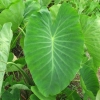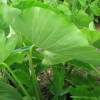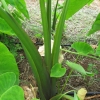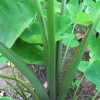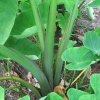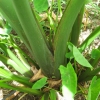Use As Food
Makes a light-colored poi of good quality; the leaves are considered very good for lū‘au.
Distribution
Grown to a limited extent, under both māla (upland) and lo‘i (wetland) cultures this is an important poi taro in a few scattered localities, the vicinity near Hana, Maui having the most extensive plantings.
General Characteristics
Medium in height, erect, maturing within about 12 months, producing from 2 to 5 ‘ohā; identified by the dark reddish-brown to purplish-brown coloration on the lower half of the Hā (Petiole) with reddish-flecked area at the kōhina (base).
Ha (Petiole)
60 to 80 cm. long, dark reddish-brown or purplish-brown on lower half, sometimes lightly tinged with green, pinkish to whitish at the lihi (stem edge), a reddish-purple ring at kōhina (base) with lighter reddish-purple, flecked area for 3 to 5 cm. above the base.
Lau or Lu'au(Leaf Blade)
40 to 50 cm. long, 25 to 35 cm. wide, 30 to 40 cm. from tip to base of sinus (māwae), narrowly egg-shaped (ovate); piko whitish to pinkish; round leaf section (lobes) obtuse with shallow, wide lihi māwae (sinus).
'I'o kalo (Corm)
Flesh white with light pinkish tinge, especially near the apex, the fibers yellowish; skin reddish.
Pua (Flower)
Remarks

